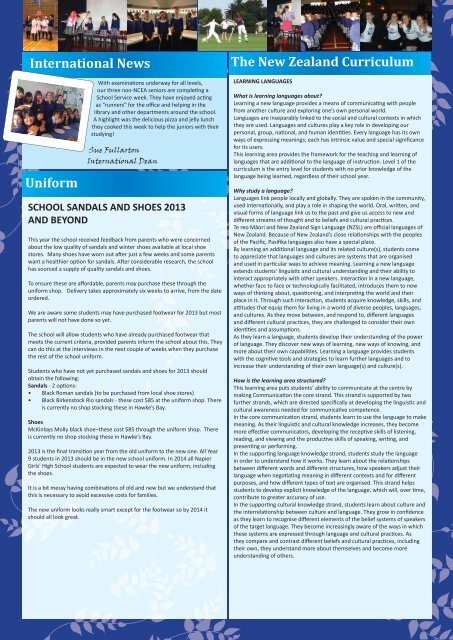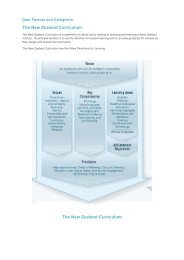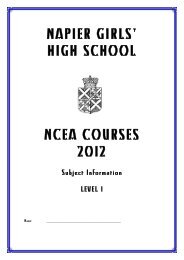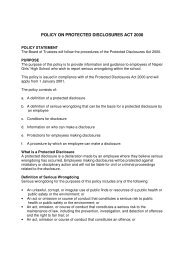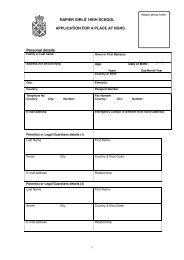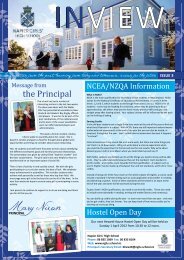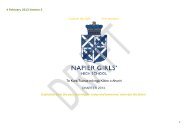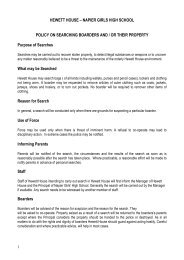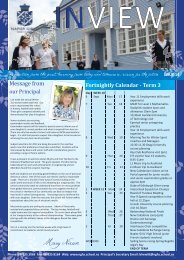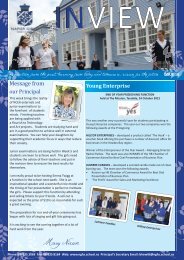Mary Nixon Message from our Principal - nghs.school.nz
Mary Nixon Message from our Principal - nghs.school.nz
Mary Nixon Message from our Principal - nghs.school.nz
Create successful ePaper yourself
Turn your PDF publications into a flip-book with our unique Google optimized e-Paper software.
International NewsUniformWith examinations underway for all levels,<strong>our</strong> three non-NCEA seniors are completing aSchool Service week. They have enjoyed actingas “runners” for the office and helping in thelibrary and other departments around the <strong>school</strong>.A highlight was the delicious pizza and jelly lunchthey cooked this week to help the juniors with theirstudying!Sue FullartonInternational DeanSCHOOL SANDALS AND SHOES 2013AND BEYONDThis year the <strong>school</strong> received feedback <strong>from</strong> parents who were concernedabout the low quality of sandals and winter shoes available at local shoestores. Many shoes have worn out after just a few weeks and some parentswant a healthier option for sandals. After considerable research, the <strong>school</strong>has s<strong>our</strong>ced a supply of quality sandals and shoes.To ensure these are affordable, parents may purchase these through theuniform shop. Delivery takes approximately six weeks to arrive, <strong>from</strong> the dateordered.We are aware some students may have purchased footwear for 2013 but mostparents will not have done so yet.The <strong>school</strong> will allow students who have already purchased footwear thatmeets the current criteria, provided parents inform the <strong>school</strong> about this. Theycan do this at the interviews in the next couple of weeks when they purchasethe rest of the <strong>school</strong> uniform.Students who have not yet purchased sandals and shoes for 2013 shouldobtain the following:Sandals - 2 options:• Black Roman sandals (to be purchased <strong>from</strong> local shoe stores)• Black Birkenstock Rio sandals - these cost $85 at the uniform shop. Thereis currently no shop stocking these in Hawke’s Bay.ShoesMcKinlays Molly black shoe–these cost $85 through the uniform shop. Thereis currently no shop stocking these in Hawke’s Bay.2013 is the final transition year <strong>from</strong> the old uniform to the new one. All Year9 students in 2013 should be in the new <strong>school</strong> uniform. In 2014 all NapierGirls’ High School students are expected to wear the new uniform, includingthe shoes.It is a bit messy having combinations of old and new but we understand thatthis is necessary to avoid excessive costs for families.The new uniform looks really smart except for the footwear so by 2014 itshould all look great.The New Zealand CurriculumLEARNING LANGUAGESWhat is learning languages about?Learning a new language provides a means of communicating with people<strong>from</strong> another culture and exploring one’s own personal world.Languages are inseparably linked to the social and cultural contexts in whichthey are used. Languages and cultures play a key role in developing <strong>our</strong>personal, group, national, and human identities. Every language has its ownways of expressing meanings; each has intrinsic value and special significancefor its users.This learning area provides the framework for the teaching and learning oflanguages that are additional to the language of instruction. Level 1 of thecurriculum is the entry level for students with no prior knowledge of thelanguage being learned, regardless of their <strong>school</strong> year.Why study a language?Languages link people locally and globally. They are spoken in the community,used internationally, and play a role in shaping the world. Oral, written, andvisual forms of language link us to the past and give us access to new anddifferent streams of thought and to beliefs and cultural practices.Te reo Māori and New Zealand Sign Language (NZSL) are official languages ofNew Zealand. Because of New Zealand’s close relationships with the peoplesof the Pacific, Pasifika languages also have a special place.By learning an additional language and its related culture(s), students cometo appreciate that languages and cultures are systems that are organisedand used in particular ways to achieve meaning. Learning a new languageextends students’ linguistic and cultural understanding and their ability tointeract appropriately with other speakers. Interaction in a new language,whether face to face or technologically facilitated, introduces them to newways of thinking about, questioning, and interpreting the world and theirplace in it. Through such interaction, students acquire knowledge, skills, andattitudes that equip them for living in a world of diverse peoples, languages,and cultures. As they move between, and respond to, different languagesand different cultural practices, they are challenged to consider their ownidentities and assumptions.As they learn a language, students develop their understanding of the powerof language. They discover new ways of learning, new ways of knowing, andmore about their own capabilities. Learning a language provides studentswith the cognitive tools and strategies to learn further languages and toincrease their understanding of their own language(s) and culture(s).How is the learning area structured?This learning area puts students’ ability to communicate at the centre bymaking Communication the core strand. This strand is supported by twofurther strands, which are directed specifically at developing the linguistic andcultural awareness needed for communicative competence.In the core communication strand, students learn to use the language to makemeaning. As their linguistic and cultural knowledge increases, they becomemore effective communicators, developing the receptive skills of listening,reading, and viewing and the productive skills of speaking, writing, andpresenting or performing.In the supporting language knowledge strand, students study the languagein order to understand how it works. They learn about the relationshipsbetween different words and different structures, how speakers adjust theirlanguage when negotiating meaning in different contexts and for differentpurposes, and how different types of text are organised. This strand helpsstudents to develop explicit knowledge of the language, which will, over time,contribute to greater accuracy of use.In the supporting cultural knowledge strand, students learn about culture andthe interrelationship between culture and language. They grow in confidenceas they learn to recognise different elements of the belief systems of speakersof the target language. They become increasingly aware of the ways in whichthese systems are expressed through language and cultural practices. Asthey compare and contrast different beliefs and cultural practices, includingtheir own, they understand more about themselves and become moreunderstanding of others.


